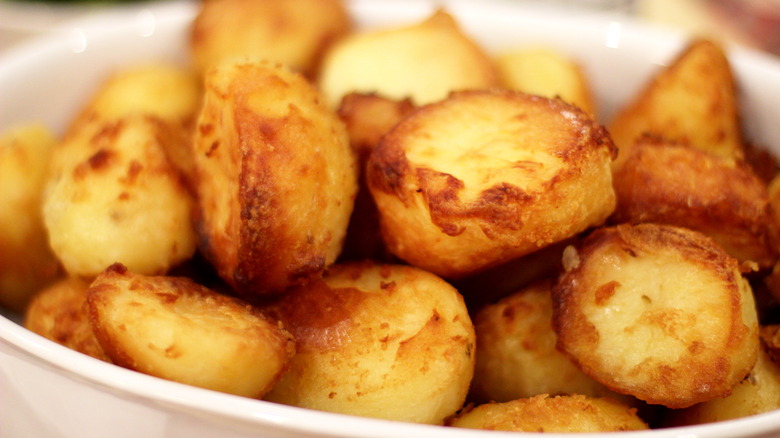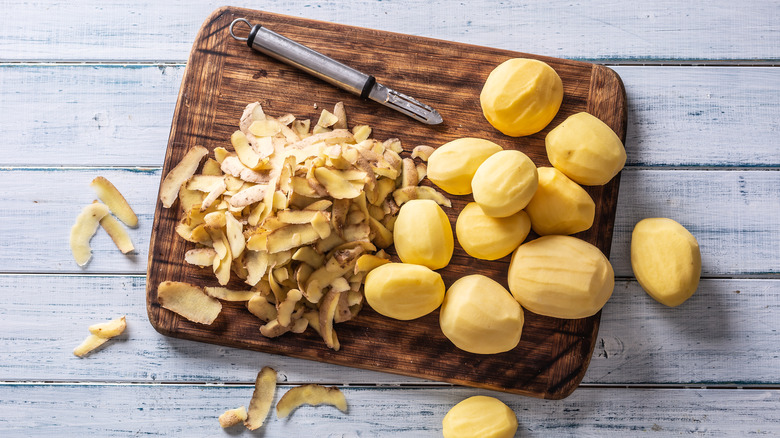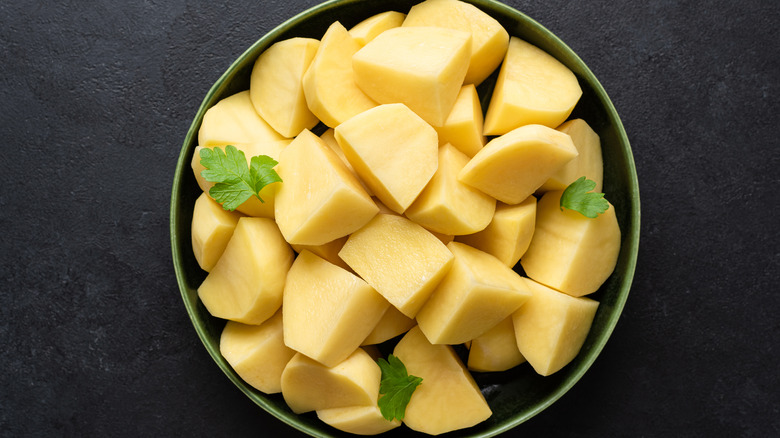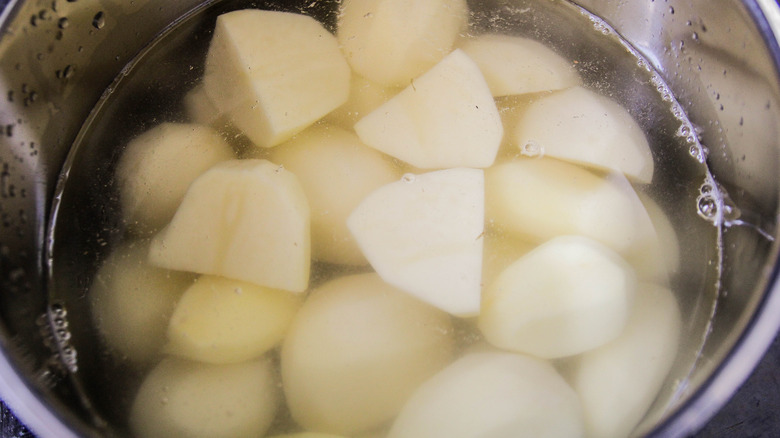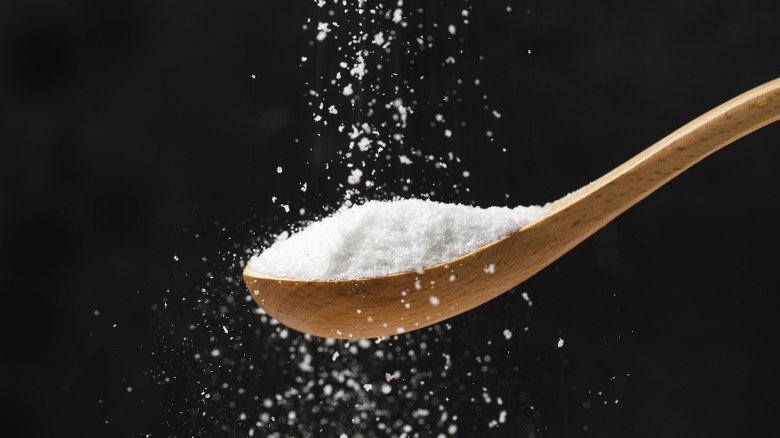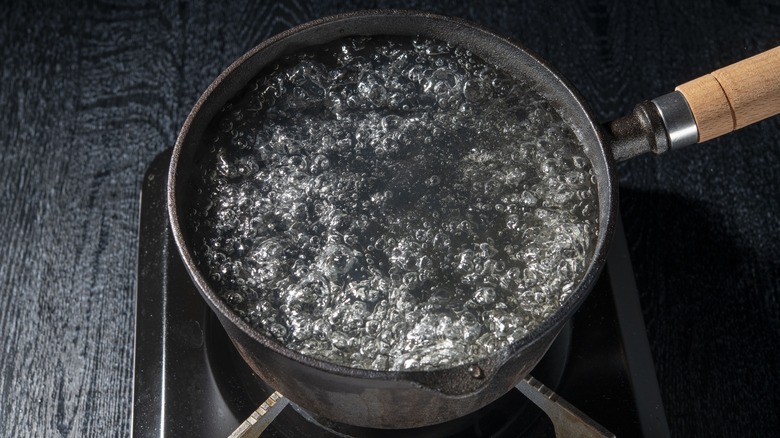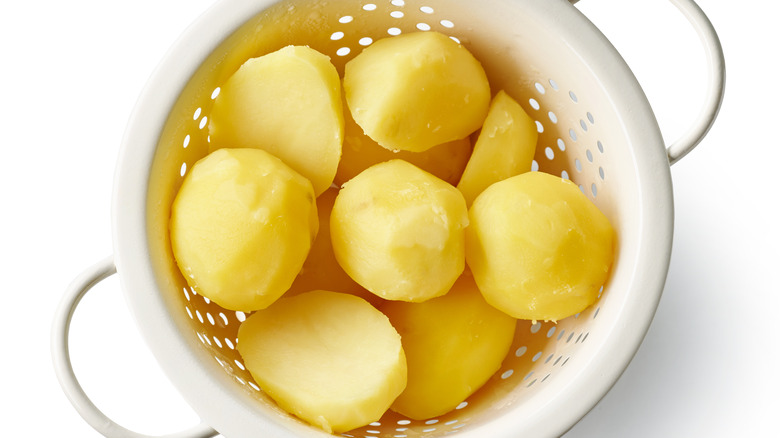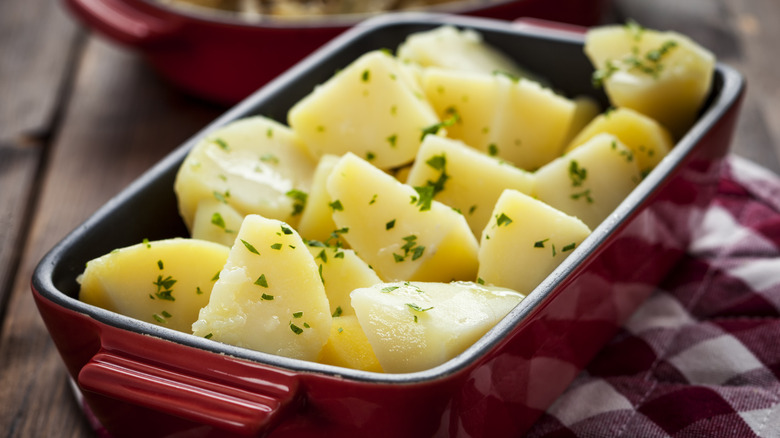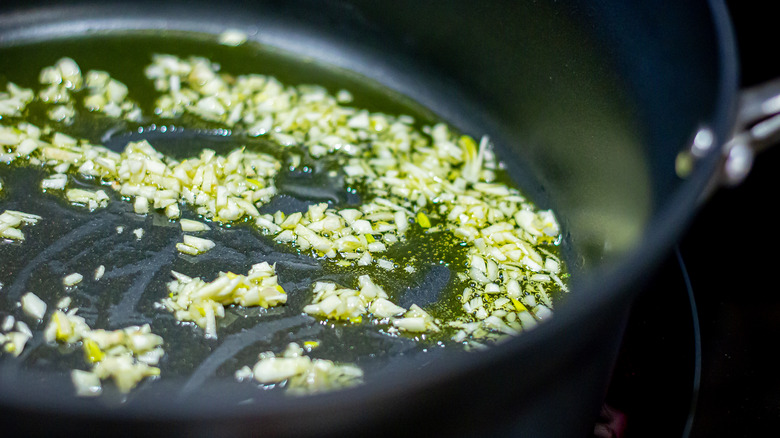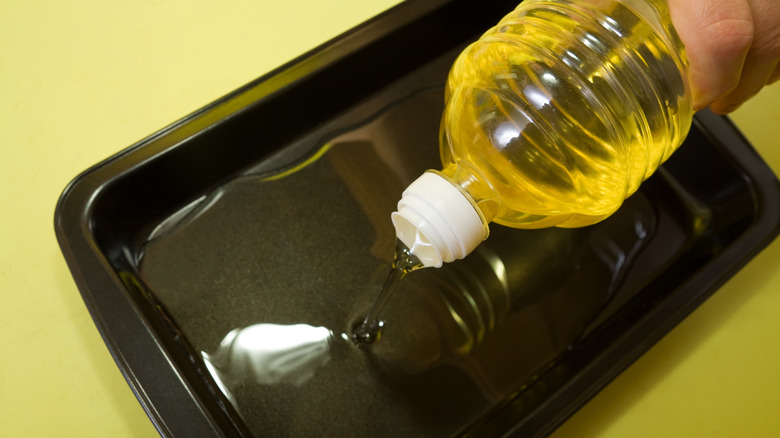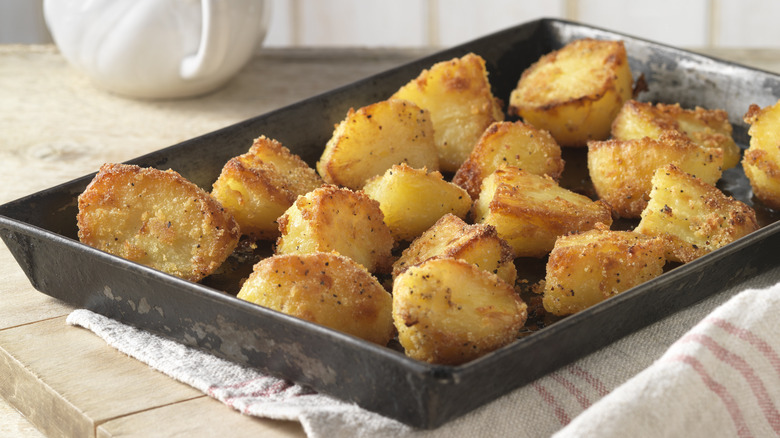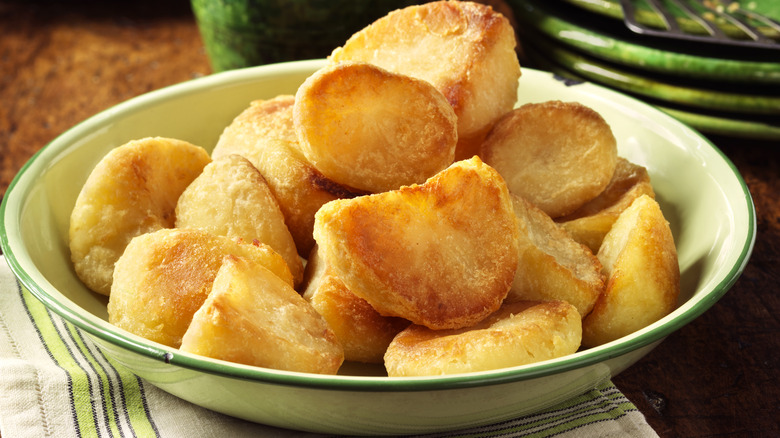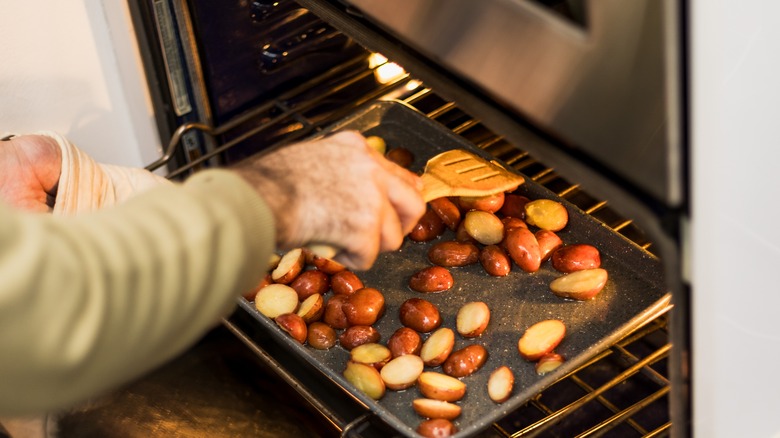Mistakes Everyone Makes When Roasting Potatoes
You might think you know how to make good roasted potatoes, but there could be some missteps holding your spuds back from being truly great. People make all kinds of mistakes when roasting potatoes and it can leave you disappointed with your dinner. There's an art to getting potatoes perfectly crunchy on the outside and incredibly fluffy on the inside. And, once you've perfected your roasties, you'll basically never want to make anything else.
Everyone deserves great roasted potatoes, so we've decided to hone in on some of the biggest errors folks make with them. From failing to parboil before roasting to crowding the pan, there are all kinds of areas where you might not even realize you're messing up.
By identifying these pain points and learning what to do instead, you can troubleshoot and make improvements. We don't think it's hyperbolic to say you'll soon be eating the best potatoes of your life. No more soggy spuds or subpar seasoning, you're going to learn how to turn things around.
Choosing the wrong type of potatoes
Potatoes are the star of the show here, and if you start with the wrong type, you're setting yourself up for failure. There's a difference between waxy and starchy varieties, and this has a big impact on the final result. Starchy potatoes are generally considered the best option. When roasted, they get a crispy exterior while maintaining a light, fluffy interior, which is what you should be aiming for with killer roasties.
Waxy potatoes have a lower starch content and hold their shape without breaking up when boiled (or parboiled). You can absolutely roast them if you want to, but you won't get the crunchy that we're looking for. Inside, they're more creamy than fluffy. If you want a middle ground, there are also all-purpose potatoes. They're somewhere between waxy and starchy, so they get nice and crispy on the outside with a creamy interior. They won't give you quite the crunch factor of starchy potatoes but it's close. You also get slightly more browning on the outside, making them more flavorful.
Perhaps the three most common potato varieties are russets, Yukon golds, and red potatoes. Of these, russets are starchy, red potatoes are waxy, and Yukon golds are somewhere in between. Depending on what you're looking for, russet and Yukon gold potatoes are your best options.
Roasting raw potatoes
You might think that you can just chop up raw spuds and stick them in the oven, but you should parboil potatoes before cooking them. Yes, they will cook through from raw if you chop them up small enough, but the results won't be the best. What's more, an ideal size is around a quarter to half of a potato (depending how big it is) and a chink of this size will be hard to get fully cooked in the center before it's overcooked on the outside.
Part of why parboiling is essential is that the process helps to form a layer of gelatinized starch on the outside. This then crisps up in the oven so you get an intensely crunchy exterior. Another reason to boil spuds before roasting them is to keep them from drying out in the oven. The heat of the oven can focus its attention on getting them cooked properly on the outside. This means they don't need to be cooked for so long that they end up shriveled and unappetizing.
But, what does it mean to parboil potatoes? It essentially means they've started to cook but haven't cooked all the way through. It gives them a head start when they start to roast, but they aren't so well-cooked that they fall apart before you can get them in the pan. To parboil potatoes, simply simmer them for around 8 to 15 minutes. Smaller chunks need less time than bigger ones.
Not boiling them with baking soda
One simple step that many people miss is putting baking soda in the water when parboiling potatoes. It might seem like a weird step. After all, baking soda is usually for leavening in baked goods. But, this technique relies on the magic of chemistry to give you extra-crispy spuds. Now, that's a good use of science.
When you add baking soda to boiling water, it raises the pH level, making the water slightly alkaline. This alkaline environment breaks down the exterior of the potato more quickly. As a result, the surface of the potato develops a crumbly, almost paste-like consistency. You might be wondering why this is good, but it achieves two things. First, it increases the potato's surface area, giving it a better crunch. This rougher texture also lets oils and seasonings stick to the potato better, so it's just tastier.
Ultimately, baking soda in the water is part of what gives you a crispy outside while the inside remains intact and fluffy. This creates contrast and, honestly, an ideal roast potato. But, you only need a small amount of baking soda — about a quarter of a teaspoon per quart of water. Too much can lead to an unpleasant, soapy taste.
Not boiling them with salt
Not salting the water when parboiling potatoes before roasting is a hugely common culinary mistake. It might seem like an insignificant step — after all, you can always salt potatoes in the roasting tin — but it can make a big difference. When potatoes are parboiled in salted water, they absorb some of it. That salted water seasons them from within. That way, the potatoes are flavorful throughout, not just on the surface.
This won't make your potatoes overly salty. In fact, you'll still need more salt to season them in the oven. But, salting the boiling water makes sure that you won't end up with potatoes that are bland inside. Salted water is an essential component in Emily Blunt's roast potato recipe that broke the internet. It was posted by Ina Garten and was so popular that her website temporarily went down because of increased traffic. How's that for a resounding approval?
Starting with cold water when you parboil your potatoes
Often, when you par-cook potatoes before roasting, you start by putting them in a pan with cold water. You gradually bring the water to a boil with the potatoes already in it, then simmer them until they've reached the right consistency. This might seem like the obvious way to do it, but it's actually wrong in this instance.
There's a reason why most potato recipes call for cold water is to keep the outside of the potato from getting mushy and falling apart before the inside is totally cooked. But, when you're parboiling spuds before roasting them, you don't need the inside to be entirely cooked, because the rest of that magic will happen in the oven. What's more, you actually want an exterior that's mushy and practically falling apart. As we explained above, this is part of what gives you a super crispy exterior.
Instead of starting with cold water, you should get the water simmering before adding the potatoes. Also, add the salt and baking soda so that they can dissolve before the spuds hit the pot. This will help you on the way to the best ever roasties.
Putting drained potatoes straight into the oil
You've parboiled your potatoes and now you're going to put them in oil to roast. Making perfect roasted potatoes isn't a quick process, so you're probably eager to get them into the oven and have dinner on the table. But, don't be hasty. Chucking straight in oil after draining them can lead to subpar spuds.
The real reason why your roast potatoes turn out soggy might be that you're failing to let them dry before putting them in the oil. The secret to that crispy exterior is the hot oil coming into contact with the potato. If there's a layer of water in the way, this is only going to impede things. Plus, it will create steam in the hot oven, meaning that soggy results are more likely.
The solution to this is simple. Drain your potatoes into a colander and leave them in the sink to drain. Within around 10 to 15 minutes, all the water will have evaporated off the surface, leaving them dry and ready to roast. If you have the time, you can also leave them in the fridge overnight to dry off. This requires some forethought but will actually save you time on the day. So, it's worth considering if you've got a big meal to prep — such as Thanksgiving or Christmas dinner — and you want to make things easier on yourself.
Failing to ruffle up the outside of the potatoes
You followed the steps to make your parboiled potatoes soft, slightly crumbly, and almost paste-like on the outside, but if you skip this one step, you won't make the most of that.You need to fluff up the edges of parboiled potatoes before roasting them. Many people overlook this step, but it's a big part of how you get that perfect combination of a crispy exterior and a fluffy or creamy interior.
As we've explained, parboiling potatoes with baking soda and starting them in boiling water gives the outside a great texture to work with for getting the ultimate crunch. But, it's not quite enough on its own. By ruffling this softened exterior, you're giving it even more surface area and texture. This increased surface area means there's more contact with the hot oil in the roasting pan. Therefore, you get crispier potatoes. What's more, these roughed up edges create nooks and crannies on the potato's surface. These areas get extra crispy in the oven and we just can't overstate how much better that makes roast potatoes.
It's super easy to ruffle the outside of your spuds. After draining, shake the colander gently. The potatoes will knock against each other and the sides of the colander, roughing up their surfaces. Just don't shake too vigorously or this might break them apart.
Not considering seasoning the oil
One way to really boost the flavor of your roast potatoes is to season the oil. And, if you're not even considering doing this, you're making a mistake. Sure, sometimes you want the purity of roasted potatoes simply seasoned with salt and pepper, but other times, a more intense punch of flavor wouldn't go amiss. You might want to add some garlic and fresh herbs, such as rosemary or sage, but there's a problem. Because of the long cooking time, garlic and fresh herbs burn before the potatoes are ready, making them taste bitter.
That's why making a seasoned oil is a better idea. To do so, first chop up some herbs and garlic (or your aromatics of choice). Then heat a generous amount of olive oil or a neutral cooking oil in a frying pan or skillet. Add the aromatics and cook them until the garlic starts to get golden and fragrant. Strain the solids from the oil and set them aside. You then use the flavored oil to cook your potatoes, which infuses them with a great taste all over. If you want an extra pop of flavor, you can toss the reserved cooked aromatics through the potatoes when they're out of the oven.
Using too little oil
When you're making roasted potatoes, using enough oil is super important. Many people don't use enough and wonder why they aren't getting the results they want. So, if you're on a mission to make the perfect roasted spuds, don't be stingy with the fat. You need plenty because it helps the potatoes get crispy on the outside. The oil gets hot in the oven, turning them golden and crunchy. Oil also stops the potatoes from sticking to the pan. This means you can easily turn them while they cook and get them out of the pan when they're done.
So how much oil should you use? The exact quantities vary from recipe to recipe. Some use as much as a third of a cup of oil per pound of potatoes. Others don't necessarily give you a quantity but rather tell you to put about a 1/4 inch of oil in the bottom of your roasting tin. This might seem like a lot, but remember that not all of it will stay on the potatoes. Some will be left in the pan. The key to getting ridiculously crispy roasties is pretty much shallow frying them in the oven. Give it a try — you can thank us later.
Crowding the pan when roasting potatoes
We get it, you probably want to make as many roast potatoes as humanly possible, but it's important not to crowd the pan. If you put too many spuds in your oven dish, they'll steam instead of roast. This is because they release moisture as they cook. So, in a crowded pan, that moisture gets trapped and turns to steam. In turn, the potatoes get soggy instead of crispy.
Giving them space in the pan lets hot air circulate. This helps your roasties brown evenly and develop a crispy outer layer. Always cook roast potatoes in a single layer. If you pile them up, you just won't get the results you want. Ideally, leave around an eighth of an inch in between individual chunks for the ultimate crunchy exterior. It's better to use two pans if you have a lot of potatoes rather than cramming them all onto one. Yes, it means more dishes to wash, but trust us. This extra step pays off. You won't be able to stop thinking about those potatoes for weeks.
Cooking the potatoes too long or not long enough
Getting the cooking time right for roast potatoes is part of getting them perfect. It can make or break them. But, so many people undercook or overcook them, spoiling them at the last hurdle. It's easy to get right once you know how, but you need to be aware of how potatoes should look when they're done and keep an eye on them.
Undercooked potatoes are too pale on the outside and won't have that crunchy finish you're aiming for. While they're unlikely to be raw in the middle, due to the parboiling, they may not achieve the perfect fluffy or creamy texture. On the other hand, overcooked potatoes will have browned too much on the outside. They might be burnt in places, giving them a bitter flavor. The exterior could be unpleasantly heard rather than perfectly crunchy.
The sweet spot for roast potatoes is usually between 50 minutes to an hour in a hot oven — around 400 F. This gives them time to get crispy on the outside and fluffy on the inside. However, you should plan for a little extra time. This way, you won't feel rushed if they need a few more minutes. You should use your senses, rather than relying on a set time. When they're done, they'll be a fairly dark golden brown over much of the surface, with some lighter areas, but not dark brown or black. If you tap them with a fork, they'll sound crisp.
Flipping your roasted potatoes too early or too often
You're on the home stretch, your potatoes are almost perfect. But, there are still ways that they can go wrong. Flipping them too early or too often is a common mistake. It might seem like it wouldn't be a problem, but it can cause problems.
You need to stop flipping your roast potatoes too soon. In a hot oven, they start to form a crispy crust on the bottom. This crust is what makes roast potatoes so tasty. If you flip them too soon, you interrupt this process. The potatoes won't have enough time to get crispy, and they might stick to the pan when you try to turn them. It's also a bad idea to flip your spuds more than once. Why? Well, it can break the crispy crust that's forming, it makes the potatoes more likely to fall apart, and it lets out heat from the oven, slowing down cooking.
So, stick to a single flip after about 30 to 40 minutes of cooking. By this time, the bottom should be golden and crispy. At this point, you need to turn them over so that they'll cook evenly and be crunchy all over. After you flip the potatoes, let them cook for another 20 to 30 minutes. Of course, cooking times can vary, so keep a watchful eye on them so they don't burn.
